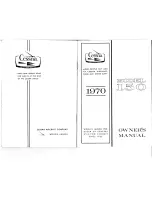
CESSNA
MODEL 172N
SECTION 4
NORMAL PROCEDURES
CROSSWIND TAKEOFF
Takeoffs into strong crosswinds normally are performed with the
minimum flap setting necessary for the field length, to minimize the drift
angle immediately after takeoff. With the ailerons partially deflected into
the wind, the airplane is accelerated to a speed slightly higher than
normal, then pulled off abruptly to prevent possible settling back to the
runway while drifting. When clear of the ground, make a coordinated turn
into the wind to correct for drift.
ENROUTE CLIMB
Normal climbs are performed with flaps up and full throttle and at
speeds 5 to 10 knots higher than best rate-of-climb speeds for the best
combination of performance, visibility and engine cooling. The rliixture
should be full rich below
3000
feet and may be leaned above
3000
feet for
smoother operation or to obtain maximum RPM. For maximum rate of
climb, use the best rate-of-climb speeds shown in the Rate-of-Climb chart
in Section 5. If an obstruction dictates the use of a steep climb angle, the
best angle-of-climb speed should be used with flaps up and maximum
power. Climbs at speeds lower than the best rate-of-climb speed should be
of short duration to improve engine cooling.
CRUISE
Normal cruising is performed between 55% and 75% power. The engine
RPM and corresponding fuel consumption for various altitudes can be
determined by using your Cessna Power Computer or the data in Section
5.
NOTE
Cruising should be done at a minimum of 75% povJ�r until
a total of 25 hours has accumulated or oil consumption has
stabilized. Operation at this higher power will ensure
proper seating of the rings and is applicable to new
engines, and engines in service following cylinder
replacement or top overhaul of one or more cylinders.
1 July 1979
4-15














































